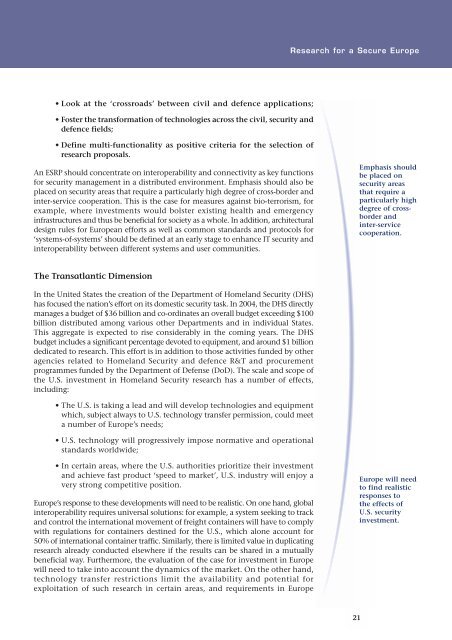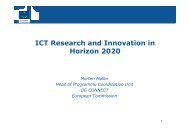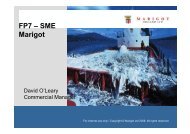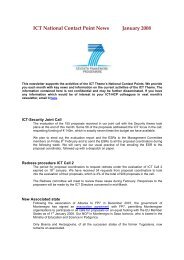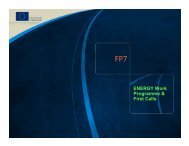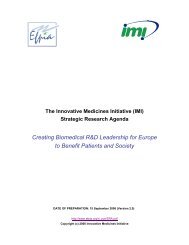Research for a Secure Europe - European Commission - Europa
Research for a Secure Europe - European Commission - Europa
Research for a Secure Europe - European Commission - Europa
Create successful ePaper yourself
Turn your PDF publications into a flip-book with our unique Google optimized e-Paper software.
<strong>Research</strong> <strong>for</strong> a <strong>Secure</strong> <strong>Europe</strong><br />
• Look at the ‘crossroads’ between civil and defence applications;<br />
• Foster the trans<strong>for</strong>mation of technologies across the civil, security and<br />
defence fields;<br />
• Define multi-functionality as positive criteria <strong>for</strong> the selection of<br />
research proposals.<br />
An ESRP should concentrate on interoperability and connectivity as key functions<br />
<strong>for</strong> security management in a distributed environment. Emphasis should also be<br />
placed on security areas that require a particularly high degree of cross-border and<br />
inter-service cooperation. This is the case <strong>for</strong> measures against bio-terrorism, <strong>for</strong><br />
example, where investments would bolster existing health and emergency<br />
infrastructures and thus be beneficial <strong>for</strong> society as a whole. In addition, architectural<br />
design rules <strong>for</strong> <strong>Europe</strong>an ef<strong>for</strong>ts as well as common standards and protocols <strong>for</strong><br />
‘systems-of-systems’ should be defined at an early stage to enhance IT security and<br />
interoperability between different systems and user communities.<br />
Emphasis should<br />
be placed on<br />
security areas<br />
that require a<br />
particularly high<br />
degree of crossborder<br />
and<br />
inter-service<br />
cooperation.<br />
The Transatlantic Dimension<br />
In the United States the creation of the Department of Homeland Security (DHS)<br />
has focused the nation’s ef<strong>for</strong>t on its domestic security task. In 2004, the DHS directly<br />
manages a budget of $36 billion and co-ordinates an overall budget exceeding $100<br />
billion distributed among various other Departments and in individual States.<br />
This aggregate is expected to rise considerably in the coming years. The DHS<br />
budget includes a significant percentage devoted to equipment, and around $1 billion<br />
dedicated to research. This ef<strong>for</strong>t is in addition to those activities funded by other<br />
agencies related to Homeland Security and defence R&T and procurement<br />
programmes funded by the Department of Defense (DoD). The scale and scope of<br />
the U.S. investment in Homeland Security research has a number of effects,<br />
including:<br />
• The U.S. is taking a lead and will develop technologies and equipment<br />
which, subject always to U.S. technology transfer permission, could meet<br />
a number of <strong>Europe</strong>’s needs;<br />
• U.S. technology will progressively impose normative and operational<br />
standards worldwide;<br />
• In certain areas, where the U.S. authorities prioritize their investment<br />
and achieve fast product ‘speed to market’, U.S. industry will enjoy a<br />
very strong competitive position.<br />
<strong>Europe</strong>’s response to these developments will need to be realistic. On one hand, global<br />
interoperability requires universal solutions: <strong>for</strong> example, a system seeking to track<br />
and control the international movement of freight containers will have to comply<br />
with regulations <strong>for</strong> containers destined <strong>for</strong> the U.S., which alone account <strong>for</strong><br />
50% of international container traffic. Similarly, there is limited value in duplicating<br />
research already conducted elsewhere if the results can be shared in a mutually<br />
beneficial way. Furthermore, the evaluation of the case <strong>for</strong> investment in <strong>Europe</strong><br />
will need to take into account the dynamics of the market. On the other hand,<br />
technology transfer restrictions limit the availability and potential <strong>for</strong><br />
exploitation of such research in certain areas, and requirements in <strong>Europe</strong><br />
<strong>Europe</strong> will need<br />
to find realistic<br />
responses to<br />
the effects of<br />
U.S. security<br />
investment.<br />
21


